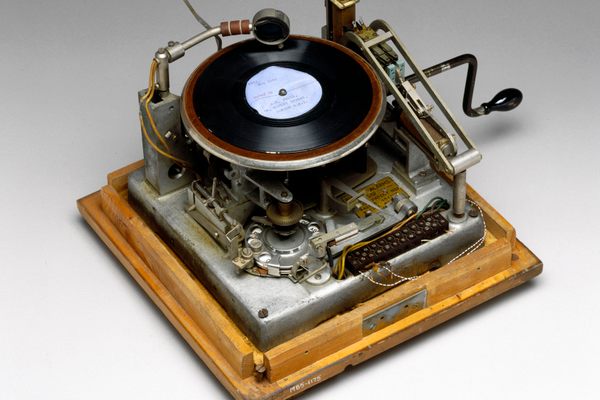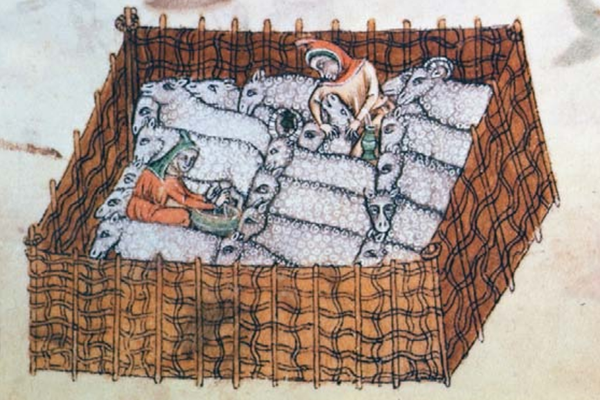Object of Intrigue: Chairman Mao’s Maori Feather Cloak

Mao in the cloak, in Inside Red China (Image: Courtesy of George Andrews)
In almost every image of Chairman Mao Zedong, he’s wearing the same thing: a simple shirt or jacket in dull gray or brown. But on China’s National Day, in October 1957, he wore on his shoulders a luxurious feather cloak checkered with burnt ombre, white and black.
The cloak, a gift from a Maori king, had come to Beijing from New Zealand, along with a small delegation of foreigners—some of the few allowed in China in this first decade of Mao’s rule. After Mao donned it that day, the cloak disappeared for almost 50 years.
In 1957, Mao had ruled China for less than a decade; the Great Leap Forward was still a year away, and the more devastating eras of his regime—the famines that came with farm reforms, the Cultural Revolution—were still further into the future. In April 1957, the New Zealand China Friendship Society had received a cable from a Chinese association responsible for cultural relations, inviting five of the society’s members to “visit China one month anytime July to October travelling our cost.” Among the small group that accepted the invitation were two filmmakers, Ramai Te Miha Hayward and her husband, Rudall.
It was the Haywards who brought the cloak for the Chairman that fall. The art of weaving cloaks had only recently begun to be revived in New Zealand: in the decades that followed colonialism, Maori people had begun wearing Western clothes, but now weavers were picking back up their old practices. In the past, Maori people had worn many different styles of cloaks, but a feather cloak, kahu huruhuru, had a particular significance. As the Museum of New Zealand Te Papa Tongarewa, which has the largest collection of Maori cloaks in the world, explains:
In the Māori world, birds are the children of Tānemahuta (god of the forest) and are messengers between people and gods. Each bird has a mauri (life force) and special qualities, and these become part of a cloak’s essence and personality.
Ramai Hayward had just a few moments to give the feather cloak to Chairman Mao. On October 1, National Day in the People’s Republic of China, she was at the celebrations at the Tiananmen gate. She was shoeless, wearing a grass skirt, and she was carrying the cloak, which had hundreds of feathers, of chicken, pheasant, swamp hen, duck, and albatross, painstaking woven onto a base of wool.
As she wrote later, in the moment she met Mao, Hayward told the Communist leader, through a translator, “We are the smallest nation in the world, giving this gift to the largest nation in the world.”
“The smallest is as great as the largest,” he replied. She placed the cloak around his shoulders and tied it tight.
While they were in China, the Haywards filmed a short documentary about the closed country, where they visited riverboat houses, Peking University, and pandas at the zoo. Rudall Hayward even filmed his wife placing the cloak around Mao’s shoulders. The Haywards tried to distribute the documentary, but in an anti-Communist era, few people were interested in the film, and it was soon forgotten—along with the cloak.

The cloak at a 2013 ceremony (Image: National Museum of China)
By the early 2000s, when New Zealand ambassador to China John McKinnon heard about Mao’s feather cloak, no one knew where it had disappeared to. Months after McKinnon first began inquiring about it, the embassy heard that China’s National Museum had a similar cloak, from Sri Lanka.
“They had sent us images and photographs which made it clear to us that it was certainly the cloak we had seen in the film,” McKinnon told George Andrews, who recently made a DVD of the Haywards’ film. “We arranged for us all to visit the museum. It was a very exciting moment when they brought it out, and it was very clear to all of us that this was the cloak.”
It turned out that the cloak had simply been mislabeled: in Chinese, the old name for Sri Lanka, Ceylon, and the name for New Zealand were very similar. In 2013, for six months, Mao’s cloak came back to New Zealand, where it was displayed as part of a traveling exhibit organized by Te Papa museum; now it’s back in China, an artifact of one very particular moment in history, when a Maori king sent a gift to Mao.















Follow us on Twitter to get the latest on the world's hidden wonders.
Like us on Facebook to get the latest on the world's hidden wonders.
Follow us on Twitter Like us on Facebook